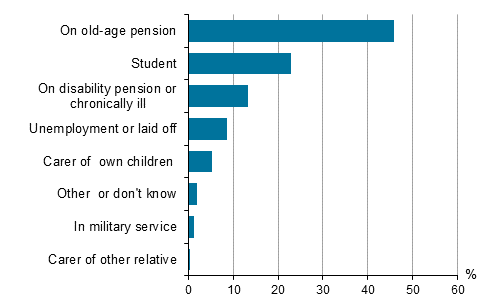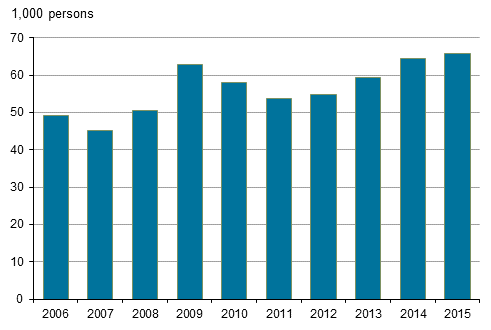4 Inactive population
4.1 Number of persons in the inactive population almost unchanged
In 2015, there were a total of 1,413,000 persons aged 15 to 74 in the inactive population, which was almost the same as in 2014. In the Labour Force Survey, the inactive population refers to persons who were not employed or unemployed during the survey week.
The Labour Force Survey also collects data on what the persons in the inactive population see as their principal activity. A majority of the inactive population, approximately 60 per cent, were on old-age or disability pension or chronically ill. Slightly under one-quarter of the inactive population were full-time students or pupils. Of the inactive population, close on one-tenth reported that they were unemployed or laid off but were not classified as unemployed in the Labour Force Survey. Around six per cent were caring for their own children or some other relative. (Figure 19.)
Figure 19. Persons in the inactive population aged 15 to 74 by main activity in 2015

Main type of activities are based on the respondent’s own reporting.
4.2 Number of persons in disguised unemployment continued growing
Persons in the inactive population who would want gainful work and would be available for work within a fortnight, but who have not looked for work in the past four weeks are considered persons in disguised unemployment in the Labour Force Survey. Persons in disguised unemployment can be considered as potential additional labour force.
In 2015, there were a total of 144,000 persons in disguised unemployment among the population aged 15 to 74. The number of persons in disguised unemployment rose to the highest level in 2015 since disguised unemployment has been reported which began in 1997. The number of persons in disguised unemployment has grown steadily since 2008, when the number was at its lowest, 77,000 persons. (Figure 20.)
The assumption that no work is available was the most common reason among persons in disguised unemployment for not seeking employment. This was believed by good one-third of persons in disguised unemployment. For close on one-fifth, the reason was studying.
In 2015, just like in previous years, most persons in disguised unemployment were found in the age group 15 to 24, in total 39,000 persons. A majority of them mentioned studying as the reason for not seeking employment. There were 32,000 persons in disguised unemployment among the age group 55 to 64 of whom a majority had not sought employment because they did not believe work was available.
In the age group 65 to 74, the number of people in disguised unemployment has increased over the past ten years from a few thousand to the current 27,000 persons. A majority of persons in disguised unemployment aged 65 to 74 had not sought employment because they were retired or they believed that work was not available.
Figure 20. Persons in disguised unemployment by age in 1997 to 2015, population aged 15 to 74

4.3 Young people not working or studying
There are a lot of full-time students among unemployed young people who are seeking, for example, part-time employment during studies or work during summer holidays. Therefore, in recent years we have, in addition to unemployment, also started monitoring the number of young people that are not working or studying This Section describes young people who are not employed and have not participated in any type of education in four weeks before the Survey and who are not performing compulsory military service either. Here, participation in education refers to both education leading to a qualification and participation in various types of courses.
In 2015, there were a total of 66,000 young people not working, studying or performing compulsory military service, which represented ten per cent of the entire 15 to 24 age group (Figure 21). Nearly 70 per cent of them considered themselves unemployed in 2015. Around 13 per cent reported that they were on disability pension or chronically ill. One in ten were caring for their children.
Figure 21. Young people aged 15 to 24 that were not working, studying or performing compulsory military service in 2006 to 2015

Even though a clear majority of young people aged 15 to 24 who are not working, studying or performing compulsory military service considered themselves unemployed and the share of disabled persons was also high, the group as a whole does not, however, represent socially excluded persons or young people at risk of social exclusion. The number of young people that are not working, studying or performing compulsory military service have been highest during summer and at the turn of the year, which partially suggests that for many this is a short period during which they prepare for entrance examinations, take a holiday, or wait in between studies, work or compulsory military service.
Nearly 80 per cent of these young people not working, studying or performing compulsory military service were aged 20 to 24 in 2015. A majority of them had completed upper secondary level education.
Source: Labour Force Survey 2015. Statistics Finland
Inquiries: Joanna Viinikka 029 551 3796, Arto Miettinen 029 551 2963, tyovoimatutkimus@stat.fi
Director in charge: Jari Tarkoma
Updated 12.4.2016
Official Statistics of Finland (OSF):
Labour force survey [e-publication].
ISSN=1798-7857. Employment and unemployment 2015,
4 Inactive population
. Helsinki: Statistics Finland [referred: 12.4.2025].
Access method: http://stat.fi/til/tyti/2015/13/tyti_2015_13_2016-04-12_kat_004_en.html

